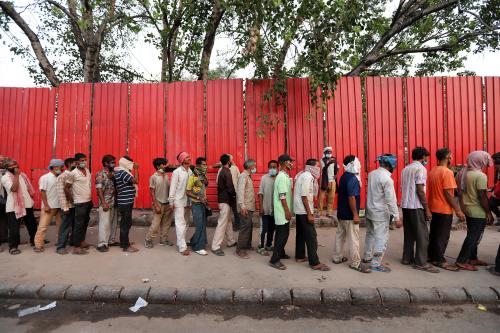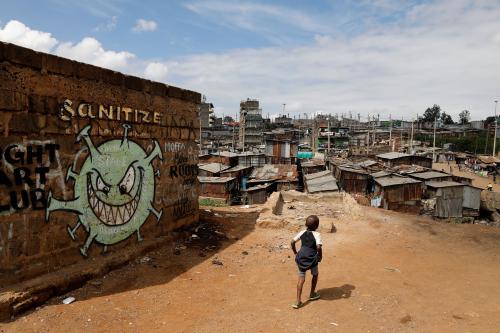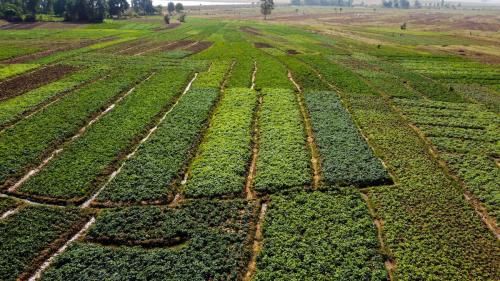The COVID-19 pandemic was accompanied by disrupted supply chains, a hike in commodity prices and inflation, increased public and private debt, and reduced economic output. Despite secular trends toward its eradication, income poverty (see here and here) suffered an increase in 2020 because of transitory conditions. Our recent research highlights an increase in “extreme poverty” by 115 million people in 2021 because of the COVID-19 effects (Figure 1). We observe a dramatic increase in poverty headcount in our COVID-19 counterfactual calculations using other poverty lines and extending the forecasting horizon from 2021 to 2030. Results on extreme poverty discussed here and here show a consensus on the direction and magnitudes of the impact of COVID-19 on headcount levels by 2021.
Figure 1. Poverty headcount by poverty lines
Source: Author’s elaboration.
Notes: SPL stands for societal poverty line: SPL = Max{ US$1.90 , US$(1 + 0.5*median) }, where median represents the daily median level of income or consumption per capita in the household survey. The SPL captures both absolute and relative features of poverty. Global aggregated poverty headcount statistics are derived from 5,000 country-specific annual random simulations from 2021 to 2040. The estimates are based on constant 2011 PPP. The baseline uses 2000–2020 information collected before the lockdown started. The COVID-19 counterfactual updates the 2020 information related to growth rates with realizations or predictions made in 2021 of the four following variables: country-specific mean income, global income, country-specific absolute inequality, and global commodity prices.
Beyond poverty headcount: Macro-poverty vulnerability
COVID-19 had another impact on poverty. Given the uncertainty around the future of the pandemic and the global economy, COVID-19 increased the number of people at risk of falling into poverty. We simulated the evolution of poverty in developing countries by considering the uncertainty around global economic growth and commodity prices and country-specific factors such as income distribution. Figure 2 shows the uncertainty embedded around global extreme poverty across time horizons.
Figure 2. Global extreme poverty and the COVID-19 crisis
Source: Author’s elaboration.
Notes: The results are based on the US$1.90 a day poverty line in constant 2011 PPP. Global aggregated poverty headcount statistics are derived from 5,000 country-specific random simulations by year from 2021 to 2040. Panel A: By 2021 and 2030, the expected poverty headcount is 8.3 percent and 5.9 percent, with a standard deviation of 0.24 percent and 0.63 percent, respectively. Panel B: By 2021 and 2030, the expected poverty headcount is 9.8 percent and 7.3 percent, with a standard deviation of 0.32 percent and 0.73 percent, respectively.
We then define the poverty-vulnerable population as those who are between the average and the 99.5 percentile of simulated poverty headcount trajectories. The COVID-19 pandemic increases the poverty-vulnerable population across all the studied poverty lines (Figure 3). We call our measure “macro-poverty vulnerability” to distinguish it from other measures of poverty vulnerability—Dang and Lanjouw (2017) and Lopez-Calva and Ortiz-Juarez (2014).
Figure 3. Poverty vulnerability by poverty lines
 Source: Author’s elaboration.
Source: Author’s elaboration.
Notes: SPL stands for Societal Poverty Line. Baseline and COVID-19 estimates use IMF GDP per capita growth rates reported in October 2019 and April 2021. The results are derived from 5,000 country-specific random draws per year.
COVID-19 effects on poverty vulnerability
The COVID-19 shock has permanently increased poverty vulnerability due to considerable uncertainty about future global prospects. The short- and long-term effects of the pandemic measured by a COVID-19 counterfactual indicate an increase in the number of people at risk of becoming poor by 40 and 107 million people by 2021 and 2030, using the $1.90 poverty line (Figure 3).
Concavity of poverty vulnerability and headcount
How does macro-poverty vulnerability vary with the poverty line? We find a concave association between the poverty headcount and poverty vulnerability (Figure 4). This concavity is pushed upward and to the right after the pandemic, indicating that society faces more poverty and a greater risk of falling into poverty after COVID-19. The highest macro-poverty vulnerability—maximum number of people potentially becoming poor across absolute poverty lines—in the global income distribution is detected around the $5.5 line in both 2021 and 2030. In 2021, the highest income-poverty-vulnerable population was approximately 330 million, with a poverty line between $3.20 and $5.50.
Figure 4. Global poverty vulnerability and headcount
 Source: Author’s elaboration.
Source: Author’s elaboration.
Notes: Baseline and COVID-19 estimates use IMF GDP per capita growth rates reported in October 2019 and April 2021. The results are derived from 5,000 country-specific random draws per year. The reported poverty headcount numbers are median estimates.
Regional extreme poverty vulnerability
Since the pandemic started, developing regions have increased extreme poverty vulnerability across horizons (Figure 5). In 2021, South Asia (SAS) and sub-Saharan Africa (SSA) were the regions with more vulnerable populations. In 2030, both the baseline and the COVID-19 counterfactual show that East Asia and the Pacific (EAP) and SSA regions would have the most poverty-vulnerable people: around 230 and 290 million people. The simulations identify that Latin America and the Caribbean (LAC) and South Asia SAS would face the most significant increase in poverty-vulnerable populations by 2030: 20 million and 55 million, approximately.
Figure 5. Regional poverty vulnerability
 Source: Author’s elaboration.
Source: Author’s elaboration.
Notes: The results are based on the $1.90 a day poverty line in constant 2011 PPP. HIC stands for high-income countries. Developing regional names: ECA stands for Europe and Central Asia, MNA denotes the Middle East and North Africa, SAS represents South Asia, LAC represents Latin America and the Caribbean, EAP stands for East Asia and the Pacific, and SSA denotes sub-Saharan Africa.
The increase in the number of vulnerable people to extreme poverty is particularly relevant in LAC. By 2030, the share of the LAC population falling under poverty vulnerability would be the highest of all regions. It would pass from 22 in the baseline to 25 percent in the COVID-19 counterfactual. Likewise, the poverty-vulnerable population share in SSA would remain high: 21 percent in both the baseline and the aftermath of the COVID-19 by 2030.
Conclusion
The exacerbation of poverty vulnerability indicates the need to establish or strengthen preventive mechanisms against global and idiosyncratic shocks affecting country-specific and regional development. Safety nets, transfers, and other poverty alleviation programs should be planned and monitored, including the latency of people falling into poverty. Vulnerability metrics such as the one described here should play a key role in diagnosing downside risks affecting poverty eradication.
The Brookings Institution is committed to quality, independence, and impact.
We are supported by a diverse array of funders. In line with our values and policies, each Brookings publication represents the sole views of its author(s).










Commentary
COVID-19 and poverty vulnerability
May 18, 2022